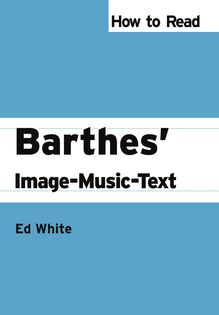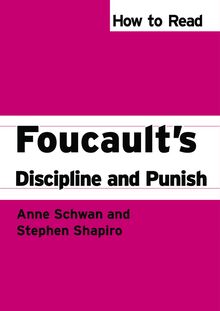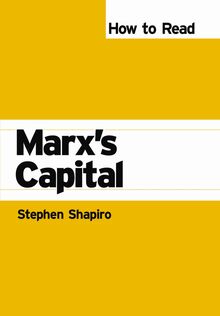How to Read Barthes' Image-Music-Text , livre ebook
93
pages
English
Ebooks
2012
Vous pourrez modifier la taille du texte de cet ouvrage
Obtenez un accès à la bibliothèque pour le consulter en ligne En savoir plus
Découvre YouScribe en t'inscrivant gratuitement
Découvre YouScribe en t'inscrivant gratuitement
93
pages
English
Ebooks
2012
Vous pourrez modifier la taille du texte de cet ouvrage
Obtenez un accès à la bibliothèque pour le consulter en ligne En savoir plus
Publié par
Date de parution
20 juillet 2012
Nombre de lectures
1
EAN13
9781849647236
Langue
English
As students are increasingly expected to write across a range of media, Barthes' work can be understood as an early mapping of what we now call interdisciplinary or multidisciplinary study. The book's detailed section-by-section readings makes Barthes' most important writings accessible to undergraduate readers.
This book is a perfect companion for teaching and learning Barthes' ideas in cultural studies and literary theory.
Introduction
1. The Photographic Message
2. The Rhetoric of the Image
3. The Third Meaning
4. Diderot, Brecht, Eisenstein
5. Introduction to the Structural Analysis of Narrative
6. The Struggle with the Angel
7. The Death of the Author
8. Musica Practica
9. From Work to Text
10. Change the Object Itself
11. Lesson in Writing
12. The Grain of the Voice
13. Writers, Intellectuals, Teachers
Index
Publié par
Date de parution
20 juillet 2012
Nombre de lectures
1
EAN13
9781849647236
Langue
English
How to Read Barthes’ Image-Music-Text
How to Read Theory
Series Editors:
Stephen Shapiro, Department of English and Comparative Literary Studies, University of Warwick Ed White, Department of English, University of Florida
How to Read Theory is a new series of clear, introductory guides to critical theory and cultural studies classics designed to encourage readers to think independently. Each title focuses on a single, key text and concisely explains its arguments and significance, showing the contemporary relevance of theory and presenting difficult theoretical concepts in clear, jargon-free prose. Presented in a compact, userfriendly format, the How to Read Theory series is designed to appeal to students and to interested readers who are coming to these key texts for the first time.
Also available:
How to Read Foucault’s Discipline and Punish
Anne Schwan and Stephen Shapiro
How to Read Marx’s Capital
Stephen Shapiro
First published 2012 by Pluto Press 345 Archway Road, London N6 5AA
www.plutobooks.com
Distributed in the United States of America exclusively by Palgrave Macmillan, a division of St. Martin’s Press LLC, 175 Fifth Avenue, New York, NY 10010
Copyright © Ed White 2012
The right of Ed White to be identified as the author of this work has been asserted by him in accordance with the Copyright, Designs and Patents Act 1988.
British Library Cataloguing in Publication Data A catalogue record for this book is available from the British Library
ISBN 978 0 7453 2958 1 Hardback ISBN 978 0 7453 2957 4 Paperback ISBN 978 1 8496 4722 9 PDF eBook ISBN 978 1 8496 4724 3 Kindle eBook ISBN 978 1 8496 4723 6 EPUB eBook
Library of Congress Cataloging in Publication Data applied for
This book is printed on paper suitable for recycling and made from fully managed and sustained forest sources. Logging, pulping and manufacturing processes are expected to conform to the environmental standards of the country of origin.
10 9 8 7 6 5 4 3 2 1
Designed and produced for Pluto Press by Chase Publishing Services Ltd Typeset from disk by Stanford DTP Services, Northampton, England Simultaneously printed digitally by CPI Antony Rowe, Chippenham, UK and Edwards Bros in the United States of America
Contents
Introduction
1. The Photographic Message
2. Rhetoric of the Image
3. The Third Meaning
4. Diderot, Brecht, Eisenstein
5. Introduction to the Structural Analysis of Narrative
6 The Struggle with the Angel
7. The Death of the Author
8. Musica Practica
9. From Work to Text
10. Change the Object Itself
11. Lesson in Writing
12. The Grain of the Voice
13. Writers, Intellectuals, Teachers
Reading Across Barthes’ Work
Index
Introduction
Image-Music-Text consists of thirteen essays published by Roland Barthes between 1961 and 1973. As a whole, the pieces track Barthes’ movement from an influential early theorist of semiotic analysis and structuralism to his emergence as a major poststructuralist thinker. Sometimes, indeed, one essay will challenge, revise, and correct the preceding essay: having offered an "Introduction to the Structural Analysis of Narrative" (1966), the next essay, "The Struggle with the Angel" (1971), asserts that it is attempting "textual analysis," not structural analysis. Stylistically, the essays include methodically analytical essays laden with highly specialized terminology (like "Structural Analysis"), more accessible critical manifestos (like "The Death of the Author"), and experimental, fragmentary projects (like "Writers, Intellectuals, Teachers"). All of the pieces are genuine "essays" in the sense that they essay, or try out, new types of analysis. This is evident, for example, in Barthes’ two most famous pieces about music, "Musica Practica" and "The Grain of the Voice," which propose divergent, if not exactly competing, frameworks.
Thus the range of styles, approaches, and conclusions may strike some readers as particularly perplexing, all the more so given the tremendous influence of this collection prepared, in 1977, by Stephen Heath. Heath was particularly interested in, and attuned to, the dynamic changes of Barthes’ work. In a 1971 interview with Barthes, he began by commenting on "a certain distance that…separates you from your earlier work," 1 and Image-Music-Text attempts to illustrate distance, movement, and change. The three thematics of its title are less guides to some Barthesian position what Barthes concluded about images, for example than fields in which Barthes worked out larger problems of language and interpretation. What this means for today’s reader of Image-Music-Text is that the collection is best approached not as an assemblage of position papers but as an entry point to certain problems that characterize Barthes and his tremendous influence. While anthologies of literary theory may reprint "The Death of the Author" as the paradigmatic Barthesian critical statement, it is more helpful to see it as one essay in a series, Barthes at work trying to address a particular set of problems and to open up a new set of solutions. How to Read Image-Music-Text attempts to be such a guide, helping new readers of Barthes appreciate the stakes, revisions, aims, and above all process of the various arguments of the collection.
What this means for you, as you read Image-Music-Text , is that you are not seeing a critic’s set positions so much as following the arcs of his writing, and I would highlight three worth tracing. The first and most obvious is Barthes’ changing positions on language, which he initially views as a system of meaning veiling reality, but increasingly comes to see as the very environment of humans comprised of both repressive elements and emancipatory potential. The latter he increasingly finds in "writing" as an activity, and the essays of Image-Music-Text can be read as Barthes’ path to becoming an exponent of that particular political attitude about language. This is a second arc that might be traced: Barthes was always friendly to radical politics, and his earliest works are typically marxist, if also contrarian, challenging orthodox positions of the Left. His critiques of leftist assumptions accelerated through the 1960s, producing a very different sense of the intellectual engaged in political change. The last essay in this collection, "Writers, Intellectuals, Teachers" (1971), demonstrates some of these shifts, though it also shows Barthes still very much interested in the marxist project. I have not offered much commentary on this political change, though I have tried to highlight how it mutates. Some have argued that Barthes’ political journey offers a needed clarity and modernization of marxism, while others suggest that we see a weakening of his politics with his institutional success. I leave that verdict for readers to determine. The third arc I would mention here concerns the dramatic changes in Barthes’ style. His earliest essays are very methodical, scientistic in tone, and focused on particular research problems. In the mid to late 1960s, however, we begin to see manifestos that are more calls to new ways of thinking than detailed arguments in the older sense. The last essay in the collection is openly experimental and fragmentary, not to mention contradictory: it is more an attempt to write out the process of thinking through several problems than it is a didactic essay with a clear message. These varying styles are among the pleasures and challenges of reading Image-Music- Text , and are best read as indications of Barthes’ changing positions on language itself. He adopts different styles of writing in part to demonstrate his claims.
On a still larger scale, a reading of Barthes’ development as a thinker how he framed problems of analysis, then revised them will provide readers with a point of access to the larger critical movement known as poststructuralism. François Dosse, in his two volume History of Structuralism , has written a long and detailed history of structuralism and poststructuralism that usefully recounts the foundational influence of structuralist linguistics and anthropology upon a range of creative and active theorists, including Michel Foucault (1926-1984), Jacques Derrida (1930-2004), Jacques Lacan (1901-1981), Julia Kristeva (1941-), and Barthes (1915-1980) all names students regularly encounter today in footnotes, if not through their original essays. Many of these theorists were strongly committed to a progressive analysis of modern capitalist society through the particular lens of language, viewed as society’s most important structure and form. Barthes was certainly among this number. If poststructuralist ideas and theories increasingly expressed pessimism about social change, a study of their development will help us see both the insights and the shortcomings of such a project in other words, not only the insights but the limitations of cultural analysis through the sign.
Before turning to the essays of Image-Music-Text , however, it will help to understand Barthes’ rise to prominence in the late 1950s, particularly with his book Mythologies . In the mid-1950s, Barthes had written short interpretive essays the "mythologies" mostly for the journal Les Lettres Nouvelles . These pieces were among the first popular examples of what might today be called "cultural studies." In generally non-specialized language, Barthes interpreted such popular media phenomena as sensational criminal trials, movie posters and acting styles, advertisements, and iconic humanitarians. He analyzed tour books, science-fiction heroes and aliens, automobile design, and the norms of cooking lay-outs in women’s magazines. He discussed sporting events, children’s toys, Einstein’s intelligence, and natural history museums. He treated wine and milk, steak and fries, plastic and wood, the U.S. preacher Billy Graham and the French striptease. In many of the pieces, he addressed French cultural politics, from


